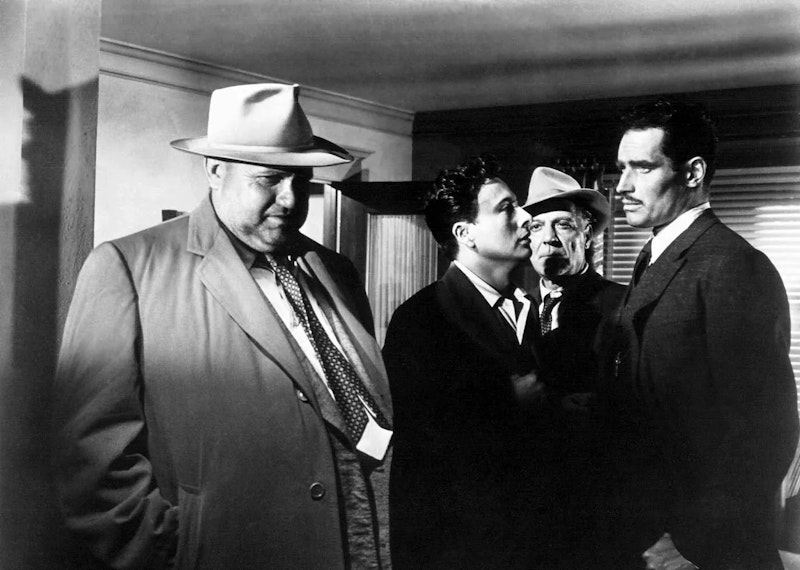The Passenger: Michelangelo Antonioni’s third and final film for MGM, his last time working with the toys and tools of Hollywood. Blow-Up is a bore, Zabriskie Point is a riot, but The Passenger is the only one of the trilogy operating on the same frequency as his L’avventura, La Notte, and L’Eclisse. Here, Jack Nicholson is the unlucky avatar of post-war malaise, a man so removed and alienated that he takes about five seconds to consider whether or not to take on the identity of the guy staying in the room next door. They’re in the middle of nowhere, hey, why not? I guess this fantasy speaks to a lot of people. Too bad the dead guy was an arms runner; now Nicholson must face international thugs, his own oblivious family and friends, and Maria Schneider, who pops up out of nowhere and escapes just as Nicholson is killed, acting as a kind of guardian angel of death, shepherding this “nobody” into the early grave he wanted all along.
The Passenger isn’t talked about as much as Antonioni’s early-1960s trilogy, or counterculture fetish object Blow-Up, or even the brazen and messy Zabriskie Point. If people do talk about The Passenger, it’s usually about its long penultimate shot, one which inches the camera through Nicholson’s room and out of the barred windows as he’s killed, and then into the courtyard as Schneider escapes and his family and the police arrive. His ex-wife: “I didn’t know him.”
William Friedkin used to talk a lot about how Antonioni “never repeated a setup”—in other words, when you’re watching an Antonioni movie, you’ll never see the same shot twice, he’s always moving on. There may be shot/reverse shot compositions, but he never goes back. I happened to catch a bit of La Notte on the Criterion Channel the other night before I saw The Passenger, and with Friedkin’s words in mind, I realized he was wrong. Antonioni went back to previous setups half a dozen times in 10 minutes, and then I stopped counting. Not the case with The Passenger: he doesn’t return to a single setup once he’s used it, and that gives an otherwise painterly but painfully slow movie the momentum it needs to come and stay alive. The Passenger is a film of visual clarity and purpose, one whose compositions and montage define the movie as much as its movie star.
Touch of Evil: Besides Citizen Kane, this is generally considered Orson Welles’ best film, but that’s a relatively recent development: released by Universal in 1958, the movie was edited into incoherence because, just as with The Magnificent Ambersons in 1942, Welles went off to work on something else as soon as shooting was over. Ambersons was a tragic but clear confluence of events: filming for the military during wartime in Brazil, Welles shot the uncompleted It’s All True while nearly half of Ambersons was cut and lost forever.
Unlike Touch of Evil and The Other Side of the Wind, which was finally released in 2018 after being talked and written about for nearly half a century, the missing Ambersons footage has yet to surface. Welles might’ve been puffing himself up about that missing second half, but probably not—this was only a year after Citizen Kane, which hasn’t dulled a bit, all hyperbole still appropriate. The Stranger is good but no Kane or Ambersons; The Lady from Shanghai is a mess because the script’s a mess, it was an assignment made under duress; his Shakespeare films are what they are, Shakespeare films—great, but for a limited audience, and by far the most threadbare productions of Welles’ career.
Threadbare is fine, but from the man who brought you Citizen Kane? Welles’ body of work is not like that of John Ford or Alfred Hitchcock or Howard Hawks, peers who produced half a dozen masterpieces; with Welles, you have Kane and everything else to sniff through yourself. Many people may love Touch of Evil, but that’s largely due to the 1998 “reconstruction” of the film based on a long, detailed memo (“a plea”) that Welles sent to Universal after seeing what they’d done to his work. You could call the overlapping dialogue, close to out of sync dub work, and manic cutting within scenes “threadbare,” but that separation, close to hostile, is what gives Touch of Evil a power beyond its third-rate police story. Practically commissioned by star Charlton Heston, Welles rewrote the script and made far and away the best Hollywood film about the Red Scare, one which goes beyond the blacklist and addresses incipient American fascism itself. As Heston spits at Welles halfway through, “Being a policeman is only easy in a police state.”
I like Touch of Evil more and more; you really do have to get the (admittedly confusing) story out of the way first, and then you have Welles as Harry Quinlan, grand wizard of the border in his last days; Marlene Dietrich as Tana, a woman with the greatest theme in Classic Hollywood (courtesy of Henry Mancini). She’s also got one of the great closing lines, looking on as Welles floats away, bloated and dead: “He was some kind of man. What does it matter what you say about people?”
—Follow Nicky Otis Smith on Twitter and Instagram: @nickyotissmith

